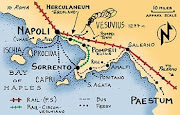Very close to Amalfi and Sorrento Coast, Cilento National Park is the second largest park in Italy, and the most important amongst the parks that border on the Mediterranean Sea. It stretches from the Tyrrhenian coast to the foot of the Apennines in Campania and Basilicata. The extraordinary naturalist complexity of the heterogeneous territory goes hand in hand with the mythical and mysterious character of a land rich in history and culture. This land melts people and civilization and preserves the evident traces of them in its distinctive characters: the Nature, the Cultural, Archaeological, Architectural Patrimony, the Territorial order soaked of medieval elements, the alive world of the Traditions. Placed at the center of the Mediterranean it is therefore its proper Park because of this sea it embodies what is the deepest spirit, the bio-diversities wealth, the environmental interpenetration, the History, synthesis of the meeting of people and different civilization.
It is a protected area comprised of several small rural towns and seaside villages. The interior area of the park has thick woods, a number of rivers, rolling green hills with olive trees and some fluvial plains. Designated as a "World Heritage Site" by the United Nations, in 1998, the Park hosts a fascinating array of natural wonders and historical sites. Here is the justification given by the U.N for the Park's designation as a World Heritage site: "The Cilento National Park is an outstanding cultural landscape. The dramatic groups of sanctuaries and settlements along its three east–west mountain ridges vividly portray the area's historical evolution: it was a major route not only for trade, but also for cultural and political interaction during the prehistoric and medieval periods. The Cilento was also the boundary between the Greek colonies of Magna Graecia and the indigenous Etruscan and Lucanian peoples. The remains of two major cities from classical times, Paestum and Velia, are found there, as well as the impressive monastic property of the Certosa di San Lorenzo in Padula." There are very few places in Italy that provide as unspoiled an environment as the Cilento Park. The long list of natural sights include dramatic grottos by the sea (Palinuro), prisine sandy beaches (Marina di Camerota), stalactite caverns (Pertosa and Castelcivita), canyons, mountains and valleys with chestnut trees and olive-groves (Castellabate), colorful wild flowers in spring and mushrooms in winter. Massif of calcareous origin host on their slopes medieval villages. The weather is ideal year round, with a typically Mediterranean climate. There are two types of vegetation in the park, Apennine and Mediterranean. Plant life ranges from fir trees to evergreen maquis. In the Cilento massifs there are wolves, wild cats, martens, polecats and badgers. Otters live along the many of the larger rivers in the Park and their respective tributaries. The Park is rich with bird life including golden eagles, black woodpeckers, kites and ravens.
All in all, Cilento Park is wonderful place to visit for nature lovers seeking to escape the crowds.
And, for those who long to admire some of the most beautiful and well-known places in the world, Pompeii, Naples, Sorrento, Capri, Ischia, Positano and the Amalfi Coast - to name a few - are all within reach of a day trip. Amalfi is at just 2 hours driving.
It is a protected area comprised of several small rural towns and seaside villages. The interior area of the park has thick woods, a number of rivers, rolling green hills with olive trees and some fluvial plains. Designated as a "World Heritage Site" by the United Nations, in 1998, the Park hosts a fascinating array of natural wonders and historical sites. Here is the justification given by the U.N for the Park's designation as a World Heritage site: "The Cilento National Park is an outstanding cultural landscape. The dramatic groups of sanctuaries and settlements along its three east–west mountain ridges vividly portray the area's historical evolution: it was a major route not only for trade, but also for cultural and political interaction during the prehistoric and medieval periods. The Cilento was also the boundary between the Greek colonies of Magna Graecia and the indigenous Etruscan and Lucanian peoples. The remains of two major cities from classical times, Paestum and Velia, are found there, as well as the impressive monastic property of the Certosa di San Lorenzo in Padula." There are very few places in Italy that provide as unspoiled an environment as the Cilento Park. The long list of natural sights include dramatic grottos by the sea (Palinuro), prisine sandy beaches (Marina di Camerota), stalactite caverns (Pertosa and Castelcivita), canyons, mountains and valleys with chestnut trees and olive-groves (Castellabate), colorful wild flowers in spring and mushrooms in winter. Massif of calcareous origin host on their slopes medieval villages. The weather is ideal year round, with a typically Mediterranean climate. There are two types of vegetation in the park, Apennine and Mediterranean. Plant life ranges from fir trees to evergreen maquis. In the Cilento massifs there are wolves, wild cats, martens, polecats and badgers. Otters live along the many of the larger rivers in the Park and their respective tributaries. The Park is rich with bird life including golden eagles, black woodpeckers, kites and ravens.
All in all, Cilento Park is wonderful place to visit for nature lovers seeking to escape the crowds.
And, for those who long to admire some of the most beautiful and well-known places in the world, Pompeii, Naples, Sorrento, Capri, Ischia, Positano and the Amalfi Coast - to name a few - are all within reach of a day trip. Amalfi is at just 2 hours driving.

Nessun commento:
Posta un commento